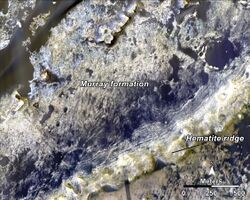Astronomy:Murray Formation
From HandWiki
The Murray Formation is the name given to a distinctive mudstone geologic formation studied by the Mars Science Laboratory (MSL) Curiosity at the Gale Crater, Mars.[1]
Stratigraphy
The formation is more than 300 metres (980 ft) thick[2] and is part of the Mount Sharp Group which interfingers with units of the Bradbury Group.[3] The formation is composed mostly of basaltic minerals plus clays, though an intermediate horizon contains tridymite, cristobalite, quartz and opal.[4]
The Murray formation has five named subunits, i.e. Pahrump Hills Member, Hartmann's Valley Member, Karasburg Member, Sutton Island Member, Vera Rubin Ridge Member.[2] It unconformably underlies the Stimson formation.[5]
References
- ↑ , Wikidata Q57852716
- ↑ 2.0 2.1 , Wikidata Q66314517
- ↑ , Wikidata Q34497447
- ↑ McSween, Harry; Moersch, Jeffrey; Burr, Devon; Dunne, William; Emery, Joshua; Kah, Linda; McCanta, Molly (2019). Planetary Geoscience. Cambridge: Cambridge University Press. pp. 302–310. ISBN 9781107145382.
- ↑ , Wikidata Q66360591
 |


